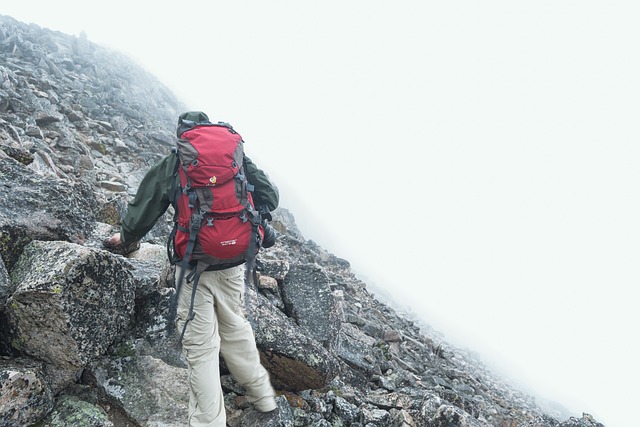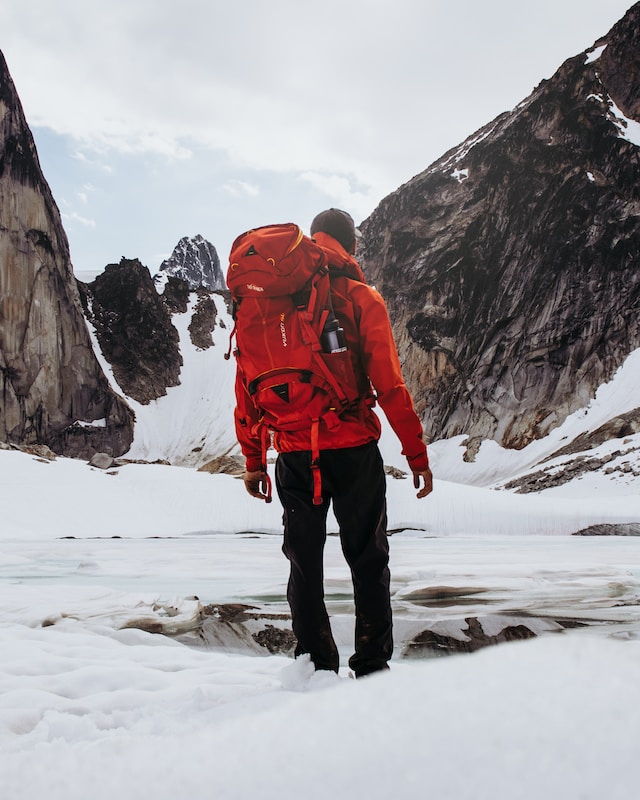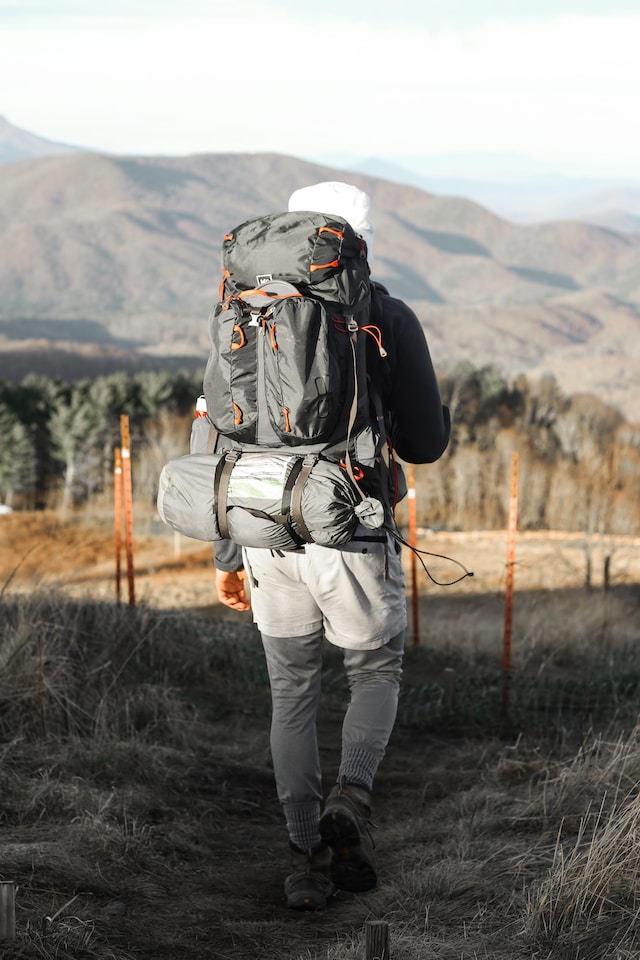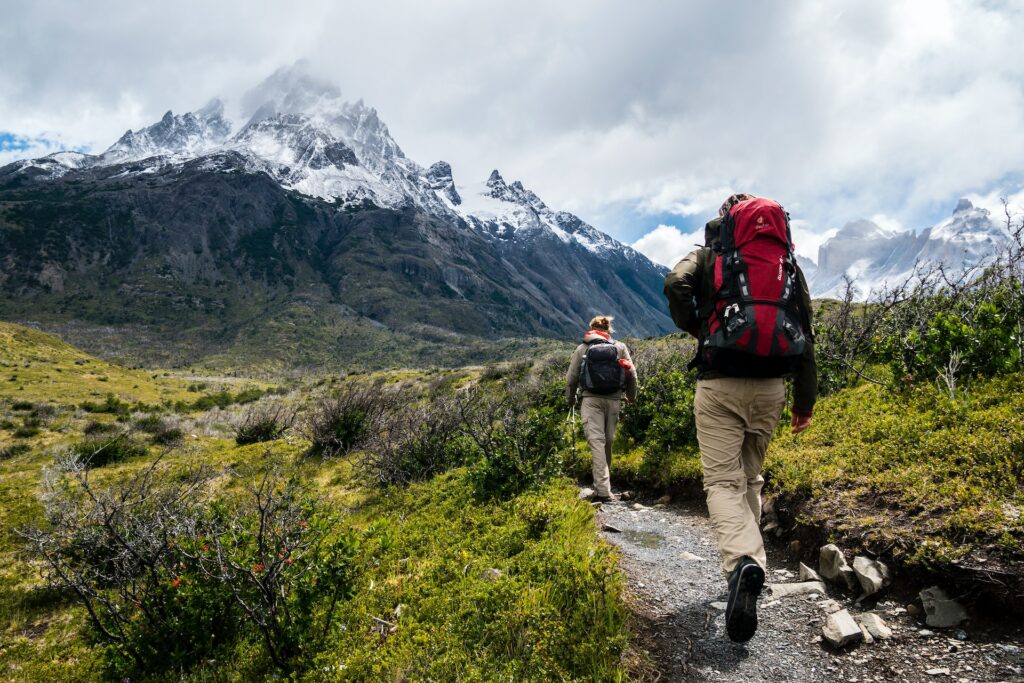Have you been looking at the different hiking backpacks on the market and wondering how to choose the right hiking backpack for you? This can be a quiet overwhelming decision process! It can be even more complicated if you’re not familiar with the anatomy of a backpack and what you should be looking for.
This post will guide you through the process of choosing the right hiking backpack that suits needs. We’ll discuss the different physical attributes of a backpack and how to determine which backpack you need based on your outdoor requirements. Then, we’ll make sure you’re up-to-speed on all the important backpack features so you can start speaking hiking-backpack-lingo.
Finally, we’ll go in-depth into how to choose the correct pack size for your body as this is the key determinant of whether a backpack is right for you or not!
Hiking Backpack Capacity
Backpacks come in different sizes or volumes, usually measured in liters. The type and duration of your hike, and activities you’ll be doing in the outdoors have a major impact on your choice of pack-bag.
Daypacks
Daypacks are the smallest type of hiking backpack. Their capacity ranges between 10-30 liters. They are ideal for short hikes up to a few hours or a day hike. On those hikes, you will typically carry the 10 essentials of hiking. You might optionally decide to carry other items that elevate your experience.
Weekend Packs
Weekend packs have a capacity of 30-50 liters and are ideal for overnight or weekend hikes. They can hold all of the gear you need for a 1-3 days on the trail, including the essentials, extra clothing, and other nice to have items.
Multi-day Packs
Multiday packs have a capacity of 50-80 liters and are designed for longer hikes of 3-5 days. They can hold a significant amount of gear required for the duration of your trip. Multi-day packs allow you to carry extra food and water you may need for longer distances or more challenging conditions.
Expedition Packs
Expedition packs are the largest type of hiking backpack, with a capacity of 70 liters or more. They are designed for extended trips of 5 days or more, up to multi-week or multi-month treks in remote areas. Expedition packs can carry all of your gear, hiking essentials, plus any additional supplies you may need.
Other considerations for how to choose the right hiking backpack capacity
Aside from the length of your hiking trip, the activities you’ll be doing and the circumstances of your trip can steer you in different directions when thinking about how to choose the right hiking backpack.
Camping
Are you going to be camping in the wild or will you be staying in accommodations during your weekend or multi-day hike? If you’ll be camping, this will add a lot more gear to your backpack. This includes a tent, sleeping bag, sleeping pad and possibly outdoor cookware. Consequently, this will tilt your decision toward a higher capacity backpack.
Weather Conditions
If you’re going to be backpacking in the winter, you will need more clothes that are typically bulkier. You might also need to carry crampons if you’ll be walking on ice or snow. Choosing a higher capacity backpack will make it easier to carry the load.
Kids
Hiking with kids can be so much fun and allows for creating lasting memories. But it also means you’ll be carrying a lot more kids’ gear as well as extra food and water. In this case, you will likely need a much larger pack than you would normally carry alone.

Hiking Backpack Construction
The manufacturing process of hiking backpacks has changed dramatically over the years. Backpack producers have gotten much more innovative in terms of material use and backpack design. Packs are very different today from what they used to be like 10-20 years ago.
Materials
Different materials are used in the making of hiking backpacks. The choice of materials has major implications on the quality, weight and durability of the pack.
- Nylon: Nylon is a durable and lightweight material that is also water-resistant. It is a good choice for backpacking packs because it can withstand heavy loads and rough terrain.
- Polyester: Polyester is another water-resistant and lightweight material. It is less expensive than nylon. Also, it is less likely to fade than nylon, and that makes it a better choice for harsh conditions. Polyester is often used in combination with nylon to create a strong and long-lasting backpack.
- Cordura: Cordura is a type of nylon that is even more durable and abrasion-resistant than regular nylon. It is often used in high-end hiking backpacks and other gear that needs to be able to withstand heavy use. The downside is that it can be a bit heavier than regular nylon or polyester.
- Ballistic nylon: Ballistic nylon is another type of nylon that is extremely durable and abrasion-resistant. It is often used in military gear and other equipment that needs to be able to withstand extreme conditions.
- Ripstop nylon: Ripstop nylon is woven with a special reinforcing technique that makes it resistant to tearing and ripping. It’s commonly used in areas prone to stress and wear. Ripstop nylon is lightweight, contributing to the overall weight efficiency of the backpack.
- Canvas: Canvas is a heavy-duty cotton fabric that is often used in backpacks because of its durability. However, canvas is not as water-resistant as nylon or polyester, so it is important to treat it with a waterproof coating if you are planning to hike in rainy weather.
- Leather: Leather is a durable and water-resistant material that is often used in high-end hiking backpacks. However, leather is heavier than nylon or polyester, and it can be more expensive.
Frame
Backpacks also come with a variety of frame types. The type of frame (or lack of) can also affect its durability, weight, and comfort.
Internal Frame
Most large backpacks today come with an internal frame made of aluminum or carbon fiber. These frames provide structural support and contribute to the durability and overall weight of the backpack. Putting such a backpack on feels like it’s hugging your body which helps in dispersing and balancing the weight of the load.
In addition to the rods (usually referred to as aluminum stays) that make up the internal frame, some backpacks come with a framesheet that helps in keeping the shape of the pack and provides additional support. It is often removable which allows you to have a slightly lighter pack. On the other hand, some backpacks have the framesheet integrated and cannot be removed.
External Frame
You can hardly find backpacks sold with an external frame nowadays. Those old school backpacks had their supporting alumnimum structure outside the back panel of the pack. However, they usually have good ventilation and can be handy when carrying heavy and irregular loads such as a huge tent for example.
Frameless
A frameless backpack is much lighter than one with a frame. But, this might not be ideal for everyone and in every situation. Frameless backpacks can be very uncomfortable under heavy loads.
So in terms of backpack construction, how to choose the right hiking backpack?
I wouldn’t recommend going for the most expensive backpack your money can buy. Everyone has their own outdoor needs. Therefore, I would advise you to choose the right hiking backpack as per your specific needs and preferences.
- If durability is a top priority, then consider backpacks with reinforced areas made from materials like Cordura or ripstop nylon.
- For lightweight backpacking, prioritize materials like ripstop nylon and focus on minimalist designs.
- If weather resistance is crucial, look for backpacks with quality waterproof coatings or materials with inherent water and harsh condition resistant properties such as polyester. Additionally, for improved durability, choose a backpack that has a blend of polyester and a type of nylon.

Hiking Backpack Features
Backpacks come with all sorts of bells and whistles. Some are more useful than others, and not every feature is going to be as useful to everyone. Obviously, more features will push the price and weight of the backpack north. Accordingly, consider the different features carefully when choosing the right hiking backpack for your specific needs.
Hip belt
Most hiking backpacks come with a breathable hip belt at their bottom. It is usually padded and has adjustable straps that allow you to tighten it to properly fit around your waist.
Sternum strap
This is a strap that allow you to connect the shoulder straps together across your chest. This results in the pack being more stable and balanced on your back, especially when walking on rough terrain. Moreover, many backpacks offer sternum straps that can be adjusted up and down. They can also be tightened or loosened to fit.
Compression straps
Compression straps are usually found on the sides or bottom of the backpack. They can be used to secure gear on the exterior of the pack. Additionally, they can be used to compress the internal contents of the backpack to ensure it is as compact and stable as can be.
Load-lifter straps
Most hiking backpacks are equipped with load lifter straps. They connect the top of the shoulder straps to the top of the pack frame. When adjusted correctly, they ensure the backpack stays close to your back rather than leaning away from it or wobbling from one side to another on the trail. Pulling the load-lifter straps just enough, usually around a 45-degree angle, is key to avoid shoulder pain.
Ventilation
Ventilation is important in a hiking backpack to help prevent the hiker from sweating too much. Note that you will inevitably sweat, there’s no way around it. But the goal is to reduce the discomfort through good ventilation that helps keep you cool, even on hot days. A couple of ventilation options you are likely to find in different backpacks:
- Mesh back panel: A mesh back panel is suspended above a concave cavity of a few inches away from the pack. This helps to circulate air and prevent your back from getting too sweaty.
- Airflow channels: Some backpacks have airflow channels that help to circulate air and keep your back cool.
Padding
Padding is important in a hiking backpack to help prevent discomfort and chafing. Good padding will help to distribute the weight of the backpack evenly and protect your body from the pack’s frame and contents. There are a few different things to look for in a hiking backpack to ensure good padding:
- Foam-padded back panel: A padded back panel offers cushioning and shock-absorption.
- Padded shoulder straps and hip belt: Padded shoulder straps and hip belt will help to distribute the weight of the backpack evenly and prevent the hiker from getting too uncomfortable at certain pressure points.
- Other padded areas: Some backpacks have additional padded areas, such as around the waist and hips, to provide extra comfort.
Pockets
Pockets are important in a hiking backpack to help you organize gear. Good pockets provide easy access and can store a array of different items.
- Variety of pockets: Look for a backpack with a variety of pockets, including large and small pockets for storing large and small pockets, and hip belt pockets for storing items that need to be easily accessible such as snacks, your phone or GPS device…etc.
- Zippered pockets: Those will help to keep some of your gear secure.
- Mesh pockets: Mesh pockets are good for storing items that need to be ventilated, such as wet clothes or snacks.
- Elasticized pockets: They can be in mesh or stretch fabric. They usually stick to the pack but also stretch to adapt to the content stored inside. These can be handy to hold water bottles, or stow a rain jacket or any extra clothing on the front of the backpack. The one on the front is usually referred to as a kangaroo pocket.
Backpack access
The type of backpack access determines how easy it is to get to your gear. Good backpack access will allow you to open the backpack and grab your stuff without taking the backpack off. Most backpacks will provide access in one or a combination of the following:
- Top loading: Top loading backpacks are the most common type of packs. They are accessed through an opening at the top of the backpack. This can be annoying if you haven’t packed properly because it’s going to be difficult to find your gear inside.
- Front loading: Front loading backpacks are less common than top loading backpacks. They are accessed through an opening at the front, giving you quick access to the main compartment quick and easy.
- Panel loading: Panel loading backpacks are accessed through a zippered opening that runs the length of the backpack making it easy to access anything in your pack.
- Multiple access: Some of the larger packs which are mostly designed for multi-day adventures tend to have multiple access points to different compartments of your backpack.
Removable daypack
A removable daypack is a small backpack that can be removed from a larger backpack, usually from the lid. Removable daypacks are useful for short day hikes or supply re-stocks on multi-day hikes.
Hydration options
Staying hydrated on the trail is key for a successful and pleasant hike. An important feature of a hiking backpack is the ability to drink water without taking the pack off your back. Your options are usually the following:
- Hydration bladder pocket: A hydration sleeve is a pocket that is designed to hold a hydration bladder. Those are water reservoirs that can be used to drink water on the go through a tube.
- Water bottle pockets: These are usually side pockets, and often elasticized, to hold your water bottle.

Sleeping bag compartment
A compartment that sits at the bottom of the backpack and is designed to hold a sleeping bag. Sleeping bag compartments are useful for backpackers who need to carry their sleeping bag with them and get quick access to them without emptying the pack itself.
External attachments
Many backpacks offer different types of attachments that can be used to secure gear to the outside of the pack. Those could include trekking pole attachments which can be buckled webbing straps, bungee cord loops or compression straps. Also, other common attachments are ice axe loops usually found at the bottom of the pack, or daisy chains which are loops that run vertically on the exterior of the backpack. Daisy chains can be used to attach extra gear that don’t fit inside the pack such as a sleeping pad.
Rain Cover
Not all backpacks are offered with a removable rain cover which usually has its dedicated storage pocket. I personally always look for this feature when choosing a backpack. This is because no matter how good a pack’s water-resistance is, under heavy downpour, water is going to find its way inside. That’s when a rain cover can help protect the contents of your pack from getting wet and possibly ruined.
How To Choose The Right Hiking Backpack Fit?
All of the features we’ve discussed up to this point can make your pack more usable and convenient. However, they are all not as nearly important in your selection process as finding the right fit for your body. The correct backpack size is not determined by your height as many people mistakenly think. Instead, the right size is determined by your torso length and waist size.
Step1: Measure your torso length
The right way to measure your torso length is to find the distance between your C7 and your iliac crest. You can find your C7 when you stand up straight and tilt your head downward. The bumpy bone at the bottom of your neck is your C7. Next, onto the other end of your torso: your iliac crest. Grab your hipbones with your thumbs pointing inwards. The intersection between your thumbs and your vertebral column is the bottom of your torso. Now, measure the distance from your C7 to this point to get your torso length.
Step 2: Measure your waist
Having a properly sized hip belt for your waist size is key, because your hips will support 60-80 percent of your backpack weight. Use measuring tape to measure the circumference of your waist. It does not need to be perfectly accurate because hip belts often have adjustable straps to tighten the belt to fit your waist. Also worth noting is that some packs come with replaceable hip belts, which allows you to swap one for another in case you need to.
Step 3: Choose the right size backpack
Many backpacks are offered in multiple sizes ranging from x-small to x-large, and the way a size translates into inches/centimeter ranges from brand to another. So, a medium at Deuter may be suitable for a torso length of 44cm-48cm (17″-19″), but that might be the range for a small or large at another brand.
Once you’ve measured your torso length and waist, and found the backpack you liked most, refer to the guidelines of the pack’s brand to determine the right size for you.
Step 4: Test your selected backpack
If you’re buying in a store, ask for assistance in packing the bag so you can test it out. Or, better yet, if you’ve made your purchase online, then pack it with the the same gear you’ll be carrying on a typical trip. Next, it’s time to try it on.
- Pull the backpack from the ground onto your back and slightly lean over so you can easily tighten the hip belt around your waist.
- Tighten your shoulder straps.
- Adjust and secure the sternum strap until you feel some tension.
- Secure the load lifters until you feel the pack is hugging your bag with almost zero gap from your shoulders.
Keep the backpack on your back for some time. Walk around, step on and off something, and do anything to simulate how the pack will be used outdoors.
Carrying the backpack should feel very comfortable. It should not be awkwardly pushing against any spots of your body in any way. Moreover, you should be feeling the bulk of the weight on your hips, not your shoulders. If that’s not the case, then you may decide to try out a different size, or unfortunately, look for a different backpack that fits you better.
Do not make the mistake of thinking it’s okay to feel a little uncomfortable. You are sure to regret the decision of keeping the backpack a couple of hours into your next hike. No matter how good the features, color or price of the backpack are, it is NOT worth hiking with sore shoulders and an aching back for years to come!

Hiking Backpack Types
When choosing a hiking backpack, it is important to consider the type of hiking you will be doing. If you are only planning on taking short day hikes, a daypack will be sufficient. However, if you are planning on going on multi-day backpacking trips or challenging mountaineering climbs, you will need a larger and more durable backpack.
| Backpack Type | Purpose | Features | Benefits |
|---|---|---|---|
| Daypacks (10-30 liters) | Short day hike |
|
|
| Mountaineering Packs (40+ liters) | Mountaineering and technical ascents |
|
|
| Backpacking Packs (40-80+ liters) | Multi-day or extended trips |
|
|
| Ultralight Backpacks (40 liters or less) | Minimal weight for speed and agility |
|
|

Conclusion
Figuring out how to choose the right hiking backpack for you is paramount. Your trekking backpack should suit your needs and preferences as this plays a major role in improving your hiking experience.
Your backpack should feel comfortable on your back, and this can only happen when you select the right sized backpack for your body shape. Beyond that, it’s crucial that you choose a backpack with the right features to allow you to carry all of your gear comfortably and conveniently.
Choosing the right backpack will help you avoid frustration on the trail and will get you excited for your next adventure every single time!
What do you look for in a backpack? Share your thoughts in the comments in section.
